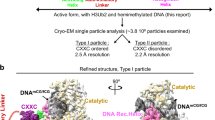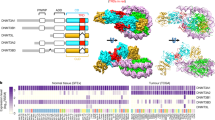Abstract
We provided evidence that competitive inhibition of poly(ADP-ribose) polymerases in mammalian cells treated with 3-aminobenzamide causes DNA hypermethylation in the genome and anomalous hypermethylation of CpG islands. The molecular mechanism(s) connecting poly(ADP-ribosyl)ation with DNA methylation is still unknown. Here we show that DNMT1 is able to bind long and branched ADP-ribose polymers in a noncovalent way. Binding of poly ADP-ribose on DNMT1 inhibits DNA methyltransferase activity. Co-immunoprecipitation reactions indicate that PARP1 and DNMT1 are associated in vivo and that in this complex PARP1 is present in its ADP-ribosylated isoform. We suggest that this complex is catalytically inefficient in DNA methylation.
This is a preview of subscription content, access via your institution
Access options
Subscribe to this journal
Receive 50 print issues and online access
$259.00 per year
only $5.18 per issue
Buy this article
- Purchase on Springer Link
- Instant access to full article PDF
Prices may be subject to local taxes which are calculated during checkout



Similar content being viewed by others
References
Aboul-Ela N, Jacobson E and Jacobson MK . (1988). Anal. Biochem., 174, 239–250.
Althaus FR, Bachmann S, Hofferer L, Kleczkowska HE, Malanga M, Panzeter PL, Realini CA and Zweifel B . (1995). Biochimie, 77, 423–432.
Amé JC, Jacobson EL and Jacobson MK . (2000). From DNA Damage and Stress Signalling to Cell Death: Poly ADP-Ribosylation Reactions De Murcia G and Shall S (eds). Oxford University Press: New York, pp. 1–34.
Antequera F and Bird A . (1993). Proc. Natl. Acad. Sci. USA, 90, 11995–11999.
Bestor TH . (2000). Hum. Mol. Genet., 9, 2395–2400.
Bestor TH and Verdine GL . (1994). Curr. Opin. Cell Biol., 6, 380–389.
Bird AP . (1986). Nature, 321, 209–213.
Bird AP . (1992). Cell, 70, 5–8.
Bird A . (2002). Genes Dev., 16, 6–21.
Bird A . (2003). Nat. Immunol., 4, 208–209.
Bird AP, Taggart M, Frommer M, Miller OJ and Macleod D . (1985). Cell, 40, 91–99.
Brandeis M, Frank D, Keshet I, Siegfried Z, Mendelsohn M, Nemes A, Temper V, Razin A and Cedar H . (1994). Nature, 371, 435–438.
Butler AJ and Ordhal CP . (1999). Mol. Cell Biol., 19, 296–306.
Clark SJ and Melki J . (2002). Oncogene, 21, 5380–5387.
Costello JF and Plass C . (2001). J. Med. Genet., 38, 285–303.
D'Amours D, Desnoyers S, D'Silva I and Poirier GG . (1999). Biochem. J., 342, 249–268.
Datta J, Ghoshal K, Sharma SM, Tajima S and Jacob ST . (2003). J. Cell. Biochem., 88, 855–864.
de Capoa A, Febbo Giovannelli FR, Niveleau A, Zardo G, Marenzi S and Caiafa P . (1999). FASEB J., 13, 89–93.
Fakan S, Leduc Y, Lamarre D, Brunet G and Poirier GG . (1988). Exp. Cell Res., 179, 517–526.
Feltus FA, Lee EK, Costello JF, Plass C and Vertino PM . (2003). Proc. Natl. Acad. Sci. USA, 21, 12253–12258.
Griesenbeck J, Ziegler M, Tomilin N, Schweiger M and Oei SL . (1999). FEBS Lett., 443, 20–24.
Hassa PO and Hottinger MO . (2002). Cell. Mol. Life Sci., 59, 1534–1553.
Jones PA and Takai D . (2001). Science, 293, 1068–1070.
Jones PA and Baylin SB . (2002). Nat. Genet., 3, 415–428.
Kraus WL and Lis JT . (2003). Cell, 113, 677–683.
Ku M-C, Stewart S and Hata A . (2003). Biochem. Biophys. Res. Commun., 311, 702–707.
Kun E, Kirsten E and Ordahl CP . (2002). J. Biol. Chem., 277, 39066–39069.
Laemmli UK . (1970). Nature, 227, 680.
Leonhardt H, Page AW, Weier H and Bestor TH . (1992). Cell, 71, 865–873.
Malanga M and Althaus FR . (1994). J. Biol. Chem., 269, 17961–17966.
Malanga M, Pleschke JM, Kleczkowska HE and Althaus FR . (1998). J. Biol. Chem., 273, 11839–11843.
Meisterernst M, Stelzer G and Roeder RG . (1997). Proc. Natl. Acad. Sci. USA, 94, 2261–2265.
Okano M, Bell DW, Haber DA and Li W . (1999). Cell, 99, 247–257.
Panzeter PL, Realini CA and Althaus FR . (1992). Biochemistry, 31, 1379–1385.
Panzeter PL, Zweifel B, Malanga M, Waser SH, Richard M and Althaus FR . (1993). J. Biol. Chem., 268, 17662–17664.
Pleschke JM, Kleczowska HE, Strohm M and Althaus FR . (2000). J. Biol. Chem., 275, 40974–40980.
Pradhan S, Bacolla A, Wells RD and Roberts RJ . (1999). J. Biol. Chem., 274, 33002–33010.
Robertson KD, Uzvolgyi E, Liang G, Talmadge C and Sumegi J . (1999). Nucleic Acids Res., 27, 2291–2298.
Rolli V, Ruf A, Augustin A, Schulz GE, Ménissier-de Murcia J and de Murcia G . (2000). From DNA Damage and Stress Signalling to Cell Death: Poly ADP-Ribosylation Reactions De Murcia G and Shall S (eds). Oxford University Press: New York, pp. 35–79.
Schmitz AA, Pleschke JM, Kleczkowska HE, Althaus FR and Vergeres G . (1998). Biochemistry, 37, 9520–9527.
Takai D and Jones PA . (2002). Proc. Natl. Acad. Sci. USA, 99, 3740–3745.
Tulin A and Spradling A . (2003). Science, 299, 560–562.
Zardo G and Caiafa P . (1998). J. Biol. Chem., 273, 16517–16520.
Zardo G, D'Erme M, Reale A, Strom R, Perilli M and Caiafa P . (1997). Biochemistry, 36, 7937–7943.
Zardo G, Marenzi S, Perilli M and Caiafa P . (1999). FASEB J., 13, 1518–1522.
Acknowledgements
We thank Dr Sriharsa Pradhan (New Enagland Biolabs) for the generous gift of human recombinant DNMT1 and we greatly appreciate his experimental suggestions and his thoughtful support. This work was supported by Ministero Italiano dell'Università (COFIN, FIRB, 60%, Progetti di Ateneo), by AIRC project (P Caiafa), by Ministero della Salute (P Caiafa) and by Istituto Pasteur Cenci Bolognetti.
Author information
Authors and Affiliations
Corresponding author
Rights and permissions
About this article
Cite this article
Reale, A., Matteis, G., Galleazzi, G. et al. Modulation of DNMT1 activity by ADP-ribose polymers. Oncogene 24, 13–19 (2005). https://doi.org/10.1038/sj.onc.1208005
Received:
Revised:
Accepted:
Published:
Issue Date:
DOI: https://doi.org/10.1038/sj.onc.1208005
Keywords
This article is cited by
-
TET-mediated DNA hydroxymethylation is negatively influenced by the PARP-dependent PARylation
Epigenetics & Chromatin (2022)
-
Increased PARylation impacts the DNA methylation process in type 2 diabetes mellitus
Clinical Epigenetics (2021)
-
PARP1-modulated chromatin remodeling is a new target for cancer treatment
Medical Oncology (2021)
-
NAD+ metabolism: pathophysiologic mechanisms and therapeutic potential
Signal Transduction and Targeted Therapy (2020)
-
Targeting DNA repair pathways: mechanisms and potential applications in cancer therapy
Genome Instability & Disease (2020)



